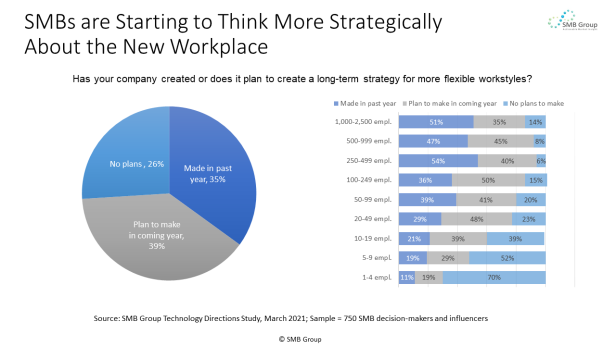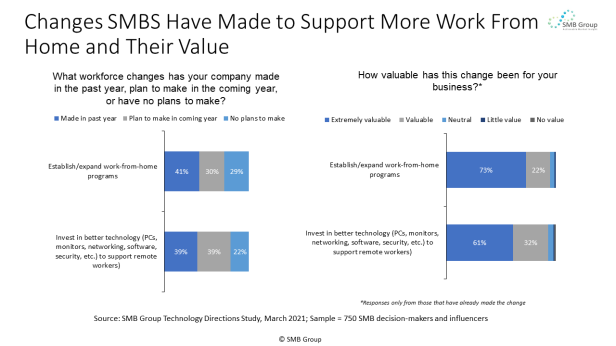If there’s a silver lining to COVID-19, it’s that many people have taken advantage of this time to pause and reflect on their lives, and ask, “What’s working and what’s not?” As a result, some have decided to change different aspects of their lives—from careers to living locations, and from lifestyles to spouses.
The shift has been seismic in the employment market—and is giving many employers heartburn. Whether you call it the great resignation, the big quit or something else, workers are deciding to leave jobs that aren’t working for them. A record-setting 4.3 million Americans quit their jobs in August, according to a report from the Bureau of Labor Statistics (BLS)—and that’s after trending upward for the prior six months. While better wages are always important, many also want work that provides more job satisfaction, and better opportunities to improve work-life balance and personal well-being.
As people rethink their life and career goals, many small and medium businesses (SMBs) are also re-evaluating their workplace, workforce, retention and hiring strategies. According to SMB Group’s SMB Technology Directions Study, 35% of SMBs say they are currently developing a more strategic approach to support more flexible workstyles, and 39% are planning to do so.
A recent episode of the podcast Remote Works called “Work, Transformed” invited a remote work researcher, tech COO, and a business school dean to share long-term hybrid workforce strategies that allow both businesses and employees to flourish in the long run.
But it can be hard to figure out where to start, what to consider, and how to get your business to where you want it to be. Here are a few tips to get started, and factors to take into consideration.
Get Input from Employees
Start by getting input from your employees. Create a safe environment for people to share what like—and don’t like about working in your company. Let them know that you want to deepen your understanding of what they value so to create a better place to work. Remember to keep them in the loop as you iterate and execute on changes.
,For instance, thanks to the pandemic, many people now expect flexible remote and hybrid work options. People like being able to use commuting time for other purposes—from exercise to spending more time with family and friends. More than 70% of workers want flexible, remote work from now on, according to Microsoft’s 2021 Work Trend Index.
But it’s not only employees that found out that remote work works. Relieved from the stress of daily commutes and a structured office schedule, many employers have learned that employees get more work done, more quickly, than if they were in the office.
SMB Group research reveals that the vast majority of SMBs that have established/expanded work from home (WFH) programs, and invested in better technology to support remote workers, have found these investments to be valuable.
Of course, not all jobs lend themselves to remote work. But all employees care about benefits—and the flexibility theme comes into play here as well. Find out what kinds of benefits people want and need, and be open to crafting some flexible benefit options to better meet individual employees’ needs. Everyone probably wants health insurance, but perhaps you can provide a choice in terms of an optional benefit—to help with childcare, commuting or pet care costs, extra vacation time, profit sharing or other perks.
Ask employees about how easy—or difficult—it is for them to get their jobs done. Identify administrative bottlenecks that slow work down, and repetitive tasks that could be automated. Solicit ideas about what would help people do their jobs more easily and quickly—regardless of location—and what tools would help them to connect and collaborate more effectively.
Put Technology to Work to Empower Employees
Adjusting to the new work normal requires shifts in both strategy and in the technology to support that strategy. Providing employees with the the solutions they need to work more effectively can energize your entire organization and help you to recruit new employees from a wider geographic talent pool.
So, it’s not surprising that, despite the havoc wrought by the pandemic, 54% of SMBs are planning to increase technology spending. Significantly, SMBs ranked improving employee productivity as the top driver to invest in technology solutions—from a list of 10 possible responses, spanning across customer, partner/supplier, operational and workforce related areas. They also rated providing flexible work options and improving employee collaboration in the top five overall drivers to invest in technology.
While many different technologies can help you to reach these goals, there are some clear-cut winners that provide big benefits:
Cloud technologies have more than proven themselves over the course of the pandemic. They are typically easier, faster and more cost-effective for companies to deploy than on-premises solutions. Other advantages come in the form of easy procurement and installation; vendor-administered updates and maintenance; automated refresh cycles; and the need for fewer internal IT staff.
Cloud technologies fuel many types of cloud platforms that can facilitate remote and hybrid work, but here are some of the most helpful ones:
- Software-as-a-service: The majority of SMBs are already embracing a cloud-first strategy when it comes to business solutions. One of the best things about SaaS is the all employees need to use SaaS solutions are a device and an Internet connection. SaaS solutions helped many SMBs to keep operations going during lockdowns, enabling employees to get their work done from anywhere—whether in finance, sales, HR or IT support. The ease of deploying, managing and scaling SaaS applications also offered many companies the agility to make changes to business strategies and operations—from enabling remote work to creating virtual services (such as fitness, telehealth, education, etc.) to replace those in the physical world.
- Unified Communications as a Service (UCaaS): As the pace of innovation accelerates, the list of communication and collaboration tools we have at our fingertips is long and always growing. But using lots of disconnected, standalone software tools to communicate and collaborate can result in a lot of friction and confusion. UCaaS platforms combine many aspect of communication—voice, video, email, chat, text, calendars, document sharing, real-time presence, even whiteboarding—into one solution. This provides users with the different tools they need for different situations, without having to jump from one application to another. This helps to streamline tasks and provides users with more of the information they need, when they need it. UCaaS providers also build capabilities such as multi-factor authentication, single sign-on, user access permissions and controls into their solutions to create a more secure collaboration environment.
- Desktop as a Service (DaaS): DaaS securely delivers virtual applications and desktops from the cloud to users’ devices. Instead of installing and accessing business applications on each user’s device, DaaS providers create and host virtual desktops in the cloud. Employees sign in via the Internet to access their desktop, replete with their SaaS, legacy applications, and operating system. This keeps everyone up-to-date, and eliminates the problem of users storing company information locally on their desktops. DaaS vendors support and manage virtualization, backup data, and oversee security and updates, relieving IT staff of many of the burdens associated with desktop applications.
Perspective
Tune into this video to hear me discuss this topic with Matt Crawford, director of Product Marketing at Citrix, and Anita Campbell, Small Business Trends Founder and CEO.
In the meantime, I’ll just sum up with this:
The pandemic shook up a lot of preconceived notions about work that both employees and employers had held in the past—and it continues to change workforce and workplace dynamics and expectations.
Most experts agree that new twists and turns will continue to unfold. We are still dealing with many unknowns in terms of how, when and even if things will settle out in this realm. However, it is clear that flexibility is an increasingly valuable commodity for both employees and employers. Employees value flexibility, and employers that can provide it will reap significant labor advantages over those that don’t.
If you are still dealing with this situation in an ad hoc way, it’s time to develop a more considered approach. And, although it may be tempting to try to revert to the “Before Times,” resist the urge to go back to a pre-pandemic playbook.
Instead, work with your employees to create a new, more flexible one that is better-adapted to employee needs. Take advantage of cloud technologies to aid collaboration and productivity, address security issues, and create a better work environment. These measures will go a long way toward fostering happier, more productive that can workforce that can help your business grow.
For more tech tips and expert resources to transform growing businesses, visit Fieldwork by Citrix.
© SMB Group
This post was sponsored by Citrix.
Source: Laurie McCabe’s Blog





